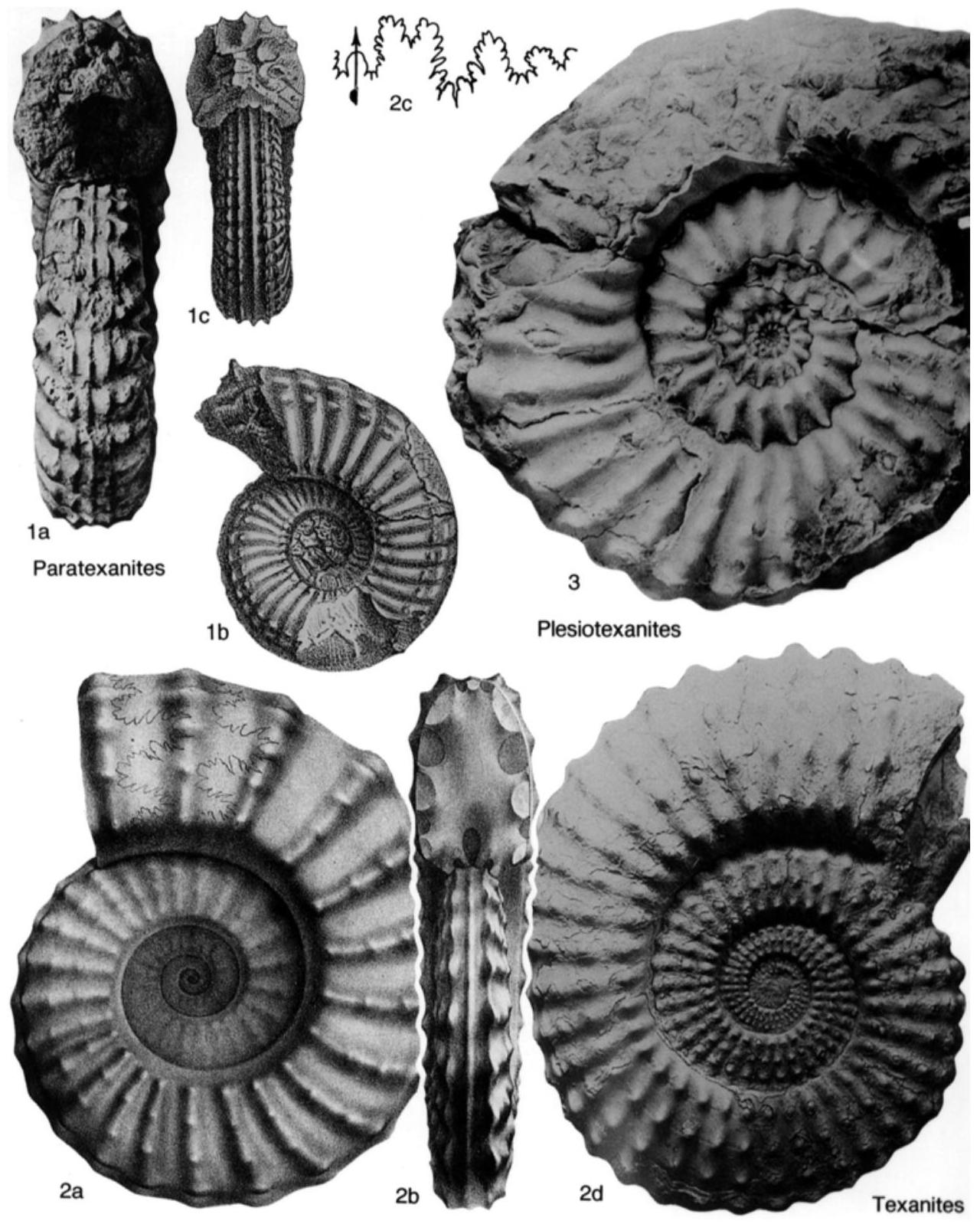Welcome to the Treatise on Invertebrate Paleontology!
Please enter a genera name to retrieve more information.

Texanites
Classification
Phylum:
Mollusca
Class:
Cephalopoda
Subclass:
Ammonoidea
Order:
Ammonitida
Suborder:
Ammonitina
Superfamily:
Acanthocerataceae
Family:
Collignoniceratidae
Subfamily:
Texanitinae
Formal Genus Name and Reference:
Texanites SPATH, 1932, p. 379
Type Species:
Ammonites texanus F. A. ROEMER, 1852, p. 31, OD
Images
(Click to enlarge in a new window)
Fig. 150,2a–c. *T. (T.) texanus (R OEMER ), Santonian, Texas; × 0.5 (Roemer, 1852).——Fig. 150,2d. T. (T.) texanus ?hispanica (COLLIGNON ), Santonian or Campanian, South Africa (Pondoland); × 0.5 (Klinger & Kennedy, 1980a).
Synonyms
Geographic Distribution
western and central Europe, Africa, Madagascar, Syria, southern India, southwestern Asia, Japan, USA, South America
Age Range
Beginning Stage in Treatise Usage:
Upper Cretaceous (Upper Coniacian)
Beginning International Stage:
Coniacian
Fraction Up In Beginning Stage:
50
Beginning Date:
87.55
Ending Stage in Treatise Usage:
Upper Cretaceous (Lower Campanian)
Ending International Stage:
Campanian
Fraction Up In Ending Stage:
50
Ending Date:
77.91
Description
Generally large, compressed, and high-whorled, with sides flat on inner part, then converging to narrow venter with entire keel, but some species are subquadrate, ribs dense, strong, straight or slightly flexuous, first with 3 then with 5 or 6 tubercles, 2 lateral ones being added to those in Protexanites, intercalated ribs rare.
References
Museum or Author Information
Classification
Phylum:
Mollusca
Class:
Cephalopoda
Subclass:
Ammonoidea
Order:
Ammonitida
Suborder:
Ammonitina
Superfamily:
Acanthocerataceae
Family:
Collignoniceratidae
Subfamily:
Texanitinae
Formal Genus Name and Reference:
Texanites SPATH, 1932, p. 379
Type Species:
Ammonites texanus F. A. ROEMER, 1852, p. 31, OD
Images
(Click to enlarge in a new window)
Fig. 150,2a–c. *T. (T.) texanus (R OEMER ), Santonian, Texas; × 0.5 (Roemer, 1852).——Fig. 150,2d. T. (T.) texanus ?hispanica (COLLIGNON ), Santonian or Campanian, South Africa (Pondoland); × 0.5 (Klinger & Kennedy, 1980a).
Synonyms
Geographic Distribution
western and central Europe, Africa, Madagascar, Syria, southern India, southwestern Asia, Japan, USA, South America
Age Range
Beginning Stage in Treatise Usage:
Upper Cretaceous (Upper Coniacian)
Beginning International Stage:
Coniacian
Fraction Up In Beginning Stage:
50
Beginning Date:
87.55
Ending Stage in Treatise Usage:
Upper Cretaceous (Lower Campanian)
Ending International Stage:
Campanian
Fraction Up In Ending Stage:
50
Ending Date:
77.91
Description
Generally large, compressed, and high-whorled, with sides flat on inner part, then converging to narrow venter with entire keel, but some species are subquadrate, ribs dense, strong, straight or slightly flexuous, first with 3 then with 5 or 6 tubercles, 2 lateral ones being added to those in Protexanites, intercalated ribs rare.
